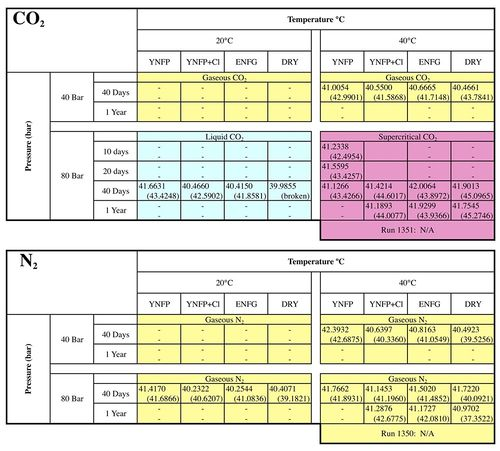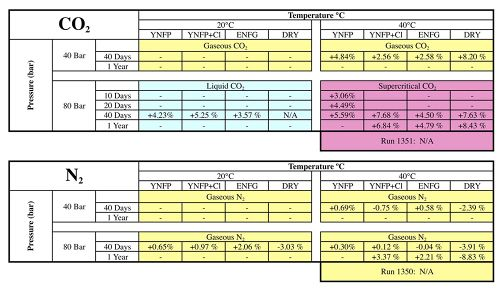OR/14/048 Results of cement size and weight change analyses
| Rochelle, C A, Purser, G, and Milodowski, A E. 2014. Results of laboratory carbonation experiments on NRVB cement. British Geological Survey Internal Report, OR/14/048. |
Dimensions of cement cores after reaction
Prior to the start of the experiments each core sample had several measurements taken of their diameter and length using a Linear Tools electronic calliper accurate to 0.01 mm. This process was repeated at the end of the experiments, after the core samples had been carefully dried, in order to ascertain if reaction with CO2 had caused any swelling or shrinkage of the cement. All cores were measured, apart from those that broke apart during the tests/during depressurisation. Care was taken when measuring post reaction samples so as to not damage delicate precipitates on the surfaces of the cement cores. We found that none of the cement cores changed size during the experiments pressurised with N2 or on exposure to CO2.
Weight of cement cores after reaction
Prior to the start of the experiments each core sample was weighed on a Mettler AT460 digital balance accurate to 0.0001 g. The average values for each core sample are given in Table 4. This process was repeated at the end of the experiments (after the core samples had been gently and carefully dried using a clean tissue) in order to ascertain if reaction with CO2 had caused any swelling or shrinkage of the cement (Table 4). All cores were measured, apart from those that broke apart during the tests/during depressurisation. Care was taken when measuring post reaction samples so as to not damage delicate precipitates on the surfaces of the cement cores. In order to give a clearer indication of the direction and degree of weight change, the information in Table 4 has been recast as percentage changes in Table 5.
| Analyte | Detection limits (instrument) # (mg l-1) |
Likely detection limits # mg l-1 mol l-1 |
Likely percentage ± uncertainty † | |
| Na | 0.35 | 7.0 |
3.1 x 10-4 | <5 |
| K | 0.5 | 10.0 | 2.6 x 10-4 | <5 |
| Mg | 0.01 | 0.2 |
8.2 x 10-6 | <5 |
| Ca | 0.1 | 2.0 |
5.0 x 10-5 | <5 |
| Sr | 0.002 | 0.5 |
5.7 x 10-6 | <5 |
| Mn | 0.002 | 0.04 |
7.2 x 10-8 | 5-10 |
| Total Fe | 0.01 | 0.2 |
3.5 x 10-6 | 5-10 |
| Al | 0.01 | 0.2 |
7.4 x 10-6 | 5-10 |
| Total S | 0.25 | 5 |
1.6 x 10-4 | <5 |
| Si | 0.075 | 1.5 |
5.4 x 10-5 | <5 to 5-10 |
| SiO2 | 0.16 | 3.21 |
5.4 x 10-5 | <5 to 5-10 |
| Cl- | 0.1 | 100 | 2.8 x 10-3 | <5 |
| SO42- | 0.3 | 30 | 3.3 x 10-4 | 5-10 |
| HCO3- | 5 | 10 | 1.6 x 10-4 | <5 to 5-10 |
| CO32- | 5 | 10 | 1.6 x 10-4 | 5-10 |
# Limits of quantification can be described in more than one way. Firstly there is the actual instrument limit for an ‘ideal’ dilute solution. However, more concentrated solutions (i.e. saline porewaters) have to be diluted prior to analysis as high concentrations of total dissolved solids cause analytical problems. Dilution causes an effective worsening of the detection limits. During this study, samples were typically diluted by; 20x for ICP analysis, 100x to 10000x for IC analysis, 2x for bicarbonate analysis, and 6x for TOC analysis.
† Illustrative uncertainties considered ‘typical’ for the concentration ranges likely to be found in this study. Concentrations <10x the detection limit have uncertainties ≥10%, concentrations >10x the detection limit have uncertainties typically ≤5%.


Several observations are apparent from the measurements of weight changes:
- For tests with dry N2 gas (non-carbonation experiments), all the cement samples lost weight. This seems to have been more pronounced with increasing pressure, temperature and especially timescale. This seems to be related to simple dehydration of the cement samples in the dry N2 gas.
- For tests with alkaline waters pressurised with N2 gas (non-carbonation experiments), there is more variation in sample weights. Generally speaking, most samples remained roughly the same weight (within ± 1%). There are 3 exceptions to this:
- - The sample reacted at 20°C and 80 bar for 40 days (+ 2.06%). This weight increase is not typical of similar samples, and may be a
- consequence of a slightly under-saturated sample at the start of the test, and which took up a little extra water when it saturated during
- the 40 days of the test.
- - The two samples reacted for a year at 80 bar (+ 3.37% and + 2.21%). These weight increases are thought to represent slow and
- continuous hydration of previously unreacted cement ‘clinker’ phases present within the cement during the long duration of the tests.
- All the tests involving CO2 (i.e. carbonation experiments) gave cement weight increases (except for the one test where the sample broke up), and these were over and above the weight changes observed in the N2-pressurised experiments. This is interpreted as carbonation of the cement minerals such as portlandite and CSH gels, with the weight gain being associated with incorporation of the CO2 into secondary phases, e.g.
- Ca(OH)2 + CO2 ⇒ CaCO3 + H2O [1]
portlandite calcite - Ca5Si6O16(OH)2.9.5H2O + 5 CO2 ⇒ 5CaCO3 + 6 SiO2 + 10.5 H2O [2]
- tobermorite (a CSH gel) calcite silica gel
- Ca(OH)2 + CO2 ⇒ CaCO3 + H2O [1]
- Reaction with CO2 resulted in weight increases that were more pronounced with increasing timescale, and especially increasing pressure and temperature. The latter two parameters probably increasing the degree of reaction through more CO2 being present in the reactors, and increased reaction kinetics.
- The largest weight increases were found in tests with just dry CO2 (weight increases of approximately 8%). In terms of molar quantities, the carbonation reaction produces at least as much water as amounts of CO2 consumed (equations [1] and [2]). A dry CO2 atmosphere would have helped remove this water from the cement sample, facilitating access of more CO2 to continue the reaction (see Reardon et al., 1989[1]).
- There are broadly similar weight gains for samples reacted with dry supercritical CO2 for 40 days and for 1 year. This suggests that the vast majority of the cement carbonation was completed in the first few weeks or reaction.
- Given that the cement samples did not change size appreciably during carbonation, but did change weight, then their average density must have increase.
References
- ↑ REARDON, E J, JAMES, B R, and ABOUCHAR, J. 1989. High pressure carbonation of cementitious grout. Cement and Concrete Research, 19, 385–399.